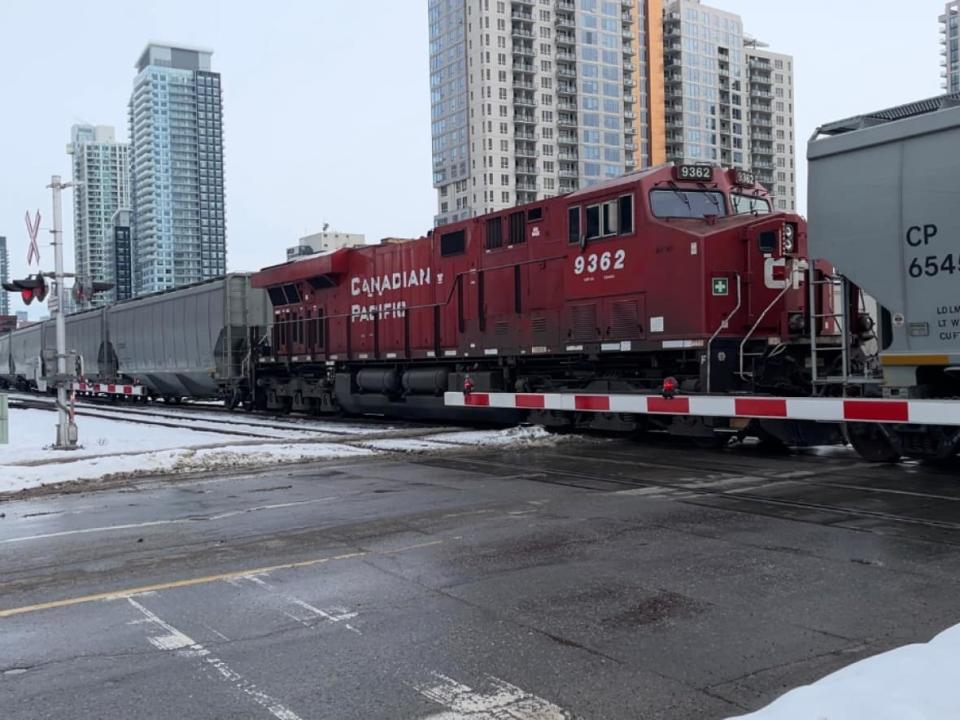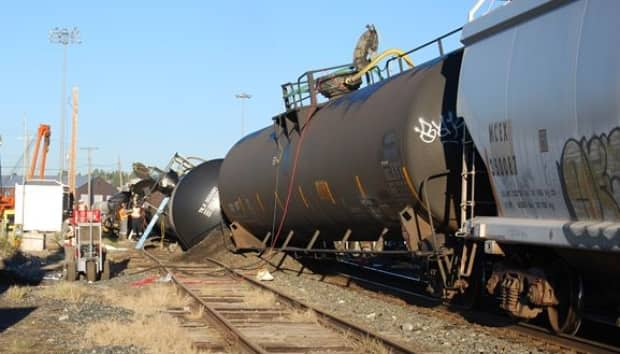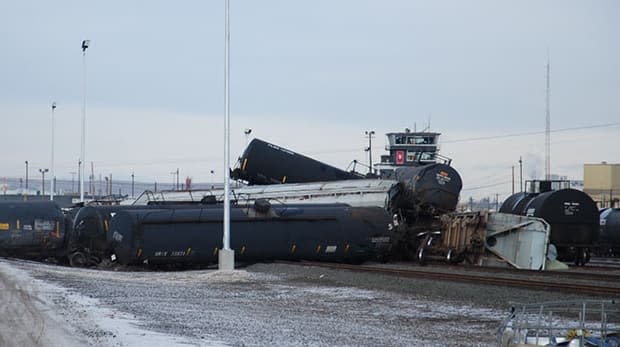Dangerous goods move through Calgary daily. What's the plan in the event of a disaster?

A toxic train derailment some 3,200 kilometres away from Calgary is putting a spotlight on rail safety in Canadian towns and cities where shipments of dangerous goods roll on a regular basis.
The City of Calgary's Disaster Risk Explorer warns that collisions, derailments and the release of hazardous goods are the types of incidents that can happen without warning. In a worst-case scenario, any of these has the potential for substantial harm to people, property, the environment and the economy.
"A major rail incident is rare," a city spokesperson said in an email, adding the industry has significant regulations, standards and protocols in place to mitigate the risk.
However, the city "is vulnerable to a rail incident as there are major rail lines carrying a high volume of dangerous goods throughout Calgary, including densely populated areas," according to the statement.
The city says it has an emergency response plan specific to freight rail corridors. It receives quarterly updates from the railways listing the dangerous goods that rumble through Calgary, and it regularly reviews safety and emergency management plans "regarding all potential risks that pose a threat to Calgary."

"That's why we, as the Calgary Fire Department, have made it a priority to have emergency response plans in place, training and resources to support an emergency response," said Deputy Chief Pete Steenaerts.
CFD training meets a number of standards set out by the National Fire Protection Association as it relates to hazardous materials, the competency of crews to deal with hazardous materials and pre-incident planning.
Calgary's fire department also trains with rail carrier personnel and their contracted responders in specialized hazardous materials training.
Ohio derailment puts spotlight on safety
On Feb. 3, a Norfolk Southern train carrying hazardous chemicals derailed near East Palestine, Ohio, igniting a fire and causing nearby homes to be evacuated.
Officials seeking to avoid an uncontrolled blast intentionally released and burned toxic vinyl chloride from five railcars, sending flames and black smoke high into the sky. That left people questioning the potential health impacts even as authorities maintained they were doing their best to protect people.
Canadian Pacific Railway, headquartered in Calgary, says it transports hazardous materials in accordance with all applicable laws, including safety and environmental protection regulations.
"We continually strive to make the transportation of hazardous materials and other goods as safe as possible, meeting or exceeding applicable regulations and industry standards, investing in our network infrastructure, implementing advanced technologies to drive safety and working with our customers to continually improve the safety of their tank cars," the company said in a statement.
"CP has led the industry with the lowest train accident frequency rate in North America for 17 straight years, illustrating the effectiveness of our efforts to enhance public safety and protect the environment."
Following the disaster in Lac-Mégantic, Que., in 2013, railways were ordered to post a public report online with the breakdown of the top 10 dangerous goods they transport through a province and provide a public report that communities can access. The order was issued under what's called Protective Direction 36.
CP Dangerous goods shipments in Alberta
CN Dangerous goods shipments in Alberta
Canadian National says it is following the same notification requirement.
"Through the Protective Direction 36, CN shares information on the type and the amount of dangerous goods moving through a community. This information is used to ensure local first responders have the appropriate tools and are trained on the appropriate response to the different products moving through the community."
Safety performance
The Railway Association of Canada says data from the last three months of 2022 show "rail safety performance was generally unfavourable across most indicators."
During that period, there were 27 accidents involving dangerous goods across Canada, including one where product was released, according to figures from the Transportation Safety Board of Canada. While that number marked a year-over-year increase, it was still slightly lower than the recent five-year average for the quarter.
Most of the safety issues during the last three months of 2022 involved trespassing or accidents at railroad crossings. Those numbers were up 45 per cent year-over-year.
Even so, the railway association cautions against drawing conclusions from the quarterly data, suggesting instead that annual figures paint a clearer picture — one that shows steady improvement over the past 15 years.
"For every railway and every railroader in Canada, safety is Job 1," said Chris Day, a spokesperson for the group. "Canada's freight railways are the safest in North America and among the safest in the world."
Indeed, CP Rail's safety record was cited in the U.S. regulator's decision earlier this month to allow the Canadian railway to take over the Kansas City Southern Railway Co.
"When you look at the safety records of all the Class I railways, CP has the safest record, and KCS is just behind it," said Martin Oberman, the chair of the Surface Transportation Board, following the board's final approval last week.
Technology improving
While the disaster in Ohio is still under investigation, a preliminary report suggested that a wheel bearing burned out, causing 38 cars to derail, including 11 carrying dangerous chemicals.
Although devices along the railway called hot box detectors noticed the bearing heating up, due to the way they were spread out across miles of the track, the emergency threshold wasn't reached until it was too late.
Paul Miller, adjunct professor at the Canadian Rail Research Laboratory at the University of Alberta, said both CP and CN have historically been at the forefront of developing technology that tracks metrics as trains move along the track.
CP Rail, the professor noted, is taking the technology a step further, incorporating vibration sensors alongside with heat sensing technology.
"They're using this as another way to predict, in advance, a bearing that's showing some signs of stress," said Miller, who is based in California.
Although such technological advances don't guarantee a derailment disaster won't happen in a Canadian city, it's yet another tool in a growing network of devices monitoring trains and railroad infrastructure across the country.
"I hope Calgarians are somewhat comforted by the fact that CP is consistently … the safest of the big railroads in North America," Miller said.
Accidents involving dangerous goods
Increasing density near railways
Ten years ago, the Railway Association of Canada partnered with the Federation of Canadian Municipalities to come up with a series of guidelines for new development in proximity to railway operations.
The report highlighted a number of steps for municipalities to consider, including building setbacks, noise and vibration mitigation, safety barriers and security fencing.
The report says as cities across Canada see the benefits of curbing urban sprawl, and as consumer demand for more housing in urban centres grows, the push to intensify existing built-up areas, including sites in proximity to railway operations, is growing steadily.
The City of Calgary created its own policy to manage development next to freight rail corridors that includes several goals:
Proactively manage the risk of development in these areas.
Ensure a high quality of life.
Facilitate responsible development.
The southeast communities of Inglewood and Ramsay are seeing more development proposals along CP's main track and rail yard in the city.

High impact, low frequency
The city councillor for the area says it took years for the city to work through its freight rail development policy. It reflects what he describes as a mature, thoughtful approach.
"And where we arrived at, was that something like Lac-Mégantic and what happened just recently in Ohio, is a very high-impact but low-frequency event," said Gian-Carlo Carra.
"When it happens, it's horrendous, but it's very rare that these things happen," he said while standing near CP Rail's main track in Inglewood.
He says the city took a very "mature" approach when it drafted the development policy.
"Rather than saying we're just going to create a 100-foot dead zone on either side of any track, we're going to be very thoughtful about how we get in and out, how the train behaves," he said.
"We're going to say, 'Look, the train we know can derail or has a higher frequency of derailing on tight curves and so we're going to armour those tight curves.'"
Carra says that means building pillars and walls that could withstand strikes from trains or train cars that have rolled or fallen off the tracks.

As for new development that is going up or being planned near the tracks?
"I think it's great as long as we are appropriately careful. And I am confident that everything that gets approved along the tracks as having the appropriate risk assessment done to it, and is being designed in a way to minimize the impact in the event of a tragedy, and it's also being designed in a way that we can get in and fix it as soon as possible."
Emergency responders are confident they're ready for any worse-case scenario.
"We collaborate closely with the railways. We have an industry-leading hazardous materials team that supports our front-line firefighters and they work very closely with the railways. And we do regular drills and training, both on-site at the Fire Department Training Academy as well as at adjacent rail facilities within the city of Calgary," said Steenaerts.
Bryan Labby is an enterprise reporter with CBC Calgary. If you have a good story idea or tip, you can reach him at bryan.labby@cbc.ca or on Twitter at @CBCBryan.

